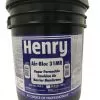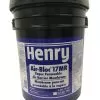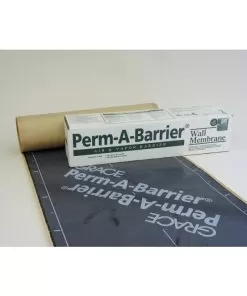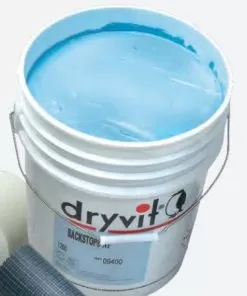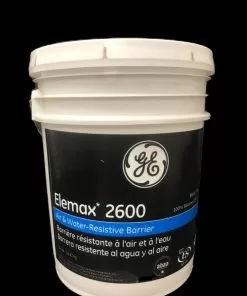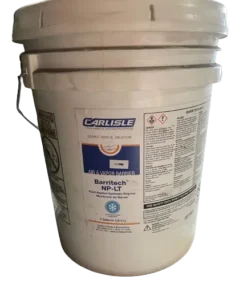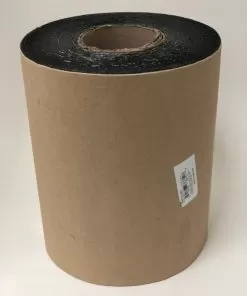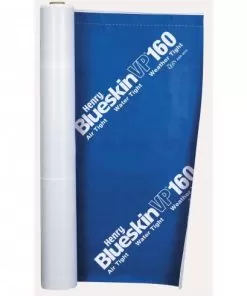Henry Air Bloc 33MR: Elastomeric Membrane
$368.72
- Seamless, vapor permeable elastomeric membrane for above grade walls
- UV-resistant, fire-resistant, mold/mildew/fungus resistant
- Water-based, does not contain mineral spirit solvents and is environmentally friendly
- Suitable for permanent weather exposure as commonly found in open-joint wall cladding systems
- Excellent adhesion to most wall construction surfaces; can be applied to damp concrete
- Meets highest industry performance standards
Out of stock
Henry Air Bloc 33MR: Elastomeric Membrane
Henry Air Bloc 33MR is a UV and fire-resistant, fluid applied, elastomeric membrane designed to provide a permeable air and water barrier when applied to above-grade wall assemblies. It is single-component, water-based and cures to a tough monolithic rubberlike membrane which resists air leakage, water penetration and long term weathering. Henry Air Bloc 33MR combines proven performance with the addition of antimicrobial technology and proprietary fire resistance technology to create an integral mold resistant membrane that achieves compliance with stringent NFPA 285 requirements. Questions? Contact Us.
Henry Air Bloc 33MR is used in construction of high performance wall assemblies requiring vapor permeability along with water, UV, weather and fire resistance. When integrated with Henry flashing and accessories, Air-Bloc
33MR forms a complete wall system meeting the highest industry performance standards. For use on a variety of wall substrates requiring long term weather exposure prior to cladding installation or with open-jointed rain screen type claddings.
Surface Prep: All surfaces must be sound, dry, clean and free of frost, oil, grease, dirt, excess mortar or other contaminants. Acceptable substrates are exterior-grade gypsum sheathing, plywood, OSB, precast or cast-in-place concrete, concrete block, primed steel, aluminum mill finish, anodized aluminum, and galvanized metal. New concrete should be cured for a minimum of 36 hours before Air-Bloc 33MR is applied. Concrete surfaces should be free of large voids and spalled areas.
Apply: Air-Bloc®
33MR may be applied by brush, roller or heavy-duty airless spray in a single or dual-coat application. Apply in
continuous, monolithic application without sags, runs or voids, transitioning onto flashing membrane to create a uniform drainage plane and air barrier. Regularly monitor wet mil thickness during application to assure adequate coverage.
Coverage Rates: Apply per published architectural specifications. Typical application rates include:
6 gal US / 100 ft² (2.0 L/m²) to give a wet film thickness of approximately 100 mils (2.54 mm), and a nominal cured dry film thickness of 55 mils (1.4mm), depending on texture and porosity of surface
Finish your job with Henry:
Henry Air Bloc Liquid Flashing
Joint and Crack Treatment: Joints between panels of exterior grade gypsum and plywood should be treated as outlined in the table below. Method #3 in the table below is recommended for plywood in applications where expansion of the joints is possible. Mortar joints on CMU walls should be struck full and flush with block surface. Cracks in masonry and concrete up to ½” (12 mm) wide shall be filled with a trowel application of 925 BES Sealant and allowed to cure overnight prior to application of the fluid applied air barrier to the surface, or alternatively, the cracks may be sealed with a strip of self-adhered sheet air barrier. Transition joints between two dissimilar asphalt compatible materials at beams, columns, window and door frames, etc., should be sealed with strips of self-adhered sheet air barrier, lapped a minimum of 3” (75 mm) on both substrates. Surfaces to receive self-adhered sheet
air barrier must be prepared per the applicable Technical Data Sheet. For non-asphalt compatible materials, contact your Henry representative for more information. Dynamic or expansion joint treatment must be in compliance with the project’s architectural details and specifications.
| Weight | 55 lbs |
|---|---|
| Dimensions | 15 × 15 × 18 in |
Related products
Air and Vapor Barrier
Air and Vapor Barrier
Air and Vapor Barrier
Air and Vapor Barrier
Air and Vapor Barrier
Air and Vapor Barrier
Air and Vapor Barrier
Air and Vapor Barrier






